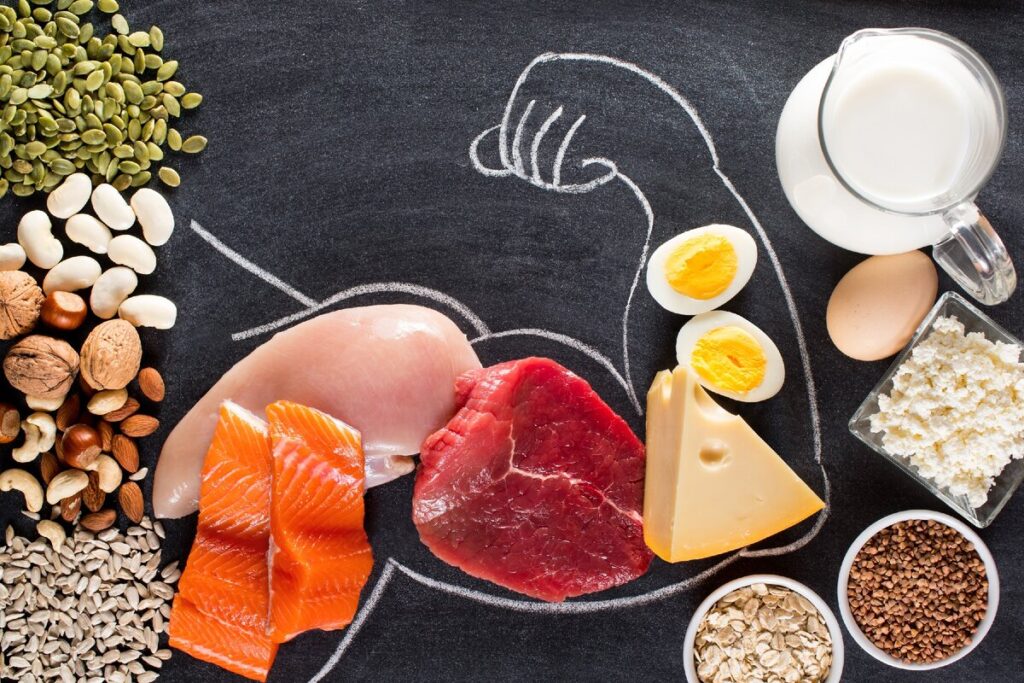If you’ve recently started strength training, you’re probably eager to see results as soon as possible. However, patience is key here. Each weightlifting session initiates a cycle of muscle damage and recovery, making your muscles stronger and more resilient with each new stage. This takes time.
Muscle protein synthesis occurs within 48 hours after weight training. The theory of muscle mass gain is based on the process of protein recovery in the body.
Protein is a key component of all tissues, including muscles. Lifting weights causes microtraumas in thousands of small fibers of each muscle. During rest, the body begins to repair damaged cells, reconnecting torn fibers and creating new ones. As a result of this process, muscles increase in size and become stronger.
It’s important to note that the presented scheme is a simplified version of the process occurring in the body after training. Not only muscles but also the nervous, endocrine, and cardiovascular systems are involved in the recovery and growth of muscles.
If your training program involves a constant increase in loads, your body constantly adapts to them, creating more muscle tissue and increasing muscle size and strength. However, workouts are not the only key factor. Let’s consider the main aspects of an athlete’s life that affect the rate of muscle growth.

Protein Synthesis Window: The muscle protein synthesis window occurs during the workout when muscles are subjected to breakdown and continues for up to 48 hours afterward. Consuming a protein shake after training and getting enough rest contribute to the process of producing new muscle protein. Various circumstances can affect the duration of this recovery period.
- Training Experience: The level of experience influences the duration of muscle protein synthesis, with novices having higher and longer synthesis compared to more experienced athletes.
- Training Intensity: High-intensity workouts sustain increased muscle protein synthesis for a longer period compared to moderate-intensity workouts.
Differences in Muscle Growth Rate Between Novices and Experienced Athletes: In novices, muscle protein synthesis is higher and lasts longer. However, this does not mean that the main muscle growth occurs immediately after starting training. Novices also experience higher muscle protein breakdown, initially compensating for losses without significant muscle mass gain.
A 2016 study published in the Journal of Physiology indicated that this growth absence period lasts about three weeks. During a 10-week period, untrained men engaged in strength exercises, and muscle protein synthesis was highest in the first week, but muscle protein breakdown was also high.
In conclusion, the rate of muscle growth is influenced by various factors, and understanding the body’s adaptation process is crucial. Patience, proper nutrition, and adequate rest play key roles in achieving sustainable muscle growth.
Approximate Muscle Growth Results in 2–3 Months of Training:
Novices:
- +5–15% muscle thickness
- +10–30% muscle area
- +2–3 kg dry mass
Experienced:
- +3–7% muscle thickness
- +6–15% muscle area
- +0.5–1.8 kg dry mass

In the early stages of training, visible mass gain is associated with increased blood flow and an inflammatory response, giving muscles temporary volume. Over time, tissues adapt, and inflammatory swelling becomes less pronounced.
As Training Experience Increases:
- The rate of protein breakdown decreases.
- Synthesis exceeds breakdown by the end of the third week. Hypertrophy begins after this “break-in period.”
Muscle Protein Synthesis vs. Breakdown: After three weeks of adapting to loads, muscle mass gain can begin. However, this requires a well-designed program, regular changes in workouts, and proper nutrition. Inadequate nutrition can slow or stop muscle mass growth, as sufficient energy and nutrients are needed to exceed protein breakdown.
Role of Calories in Increasing Muscle Growth Rate: The number of consumed calories has a more significant impact on muscle growth than the amount of protein consumed. Caloric deficit means the body receives less energy than required for basic physiological functions, including protein synthesis and physical activity. A deficit directs the body to use fat stores, which can be beneficial for short-term weight loss. However, for muscle mass gain, a sufficient energy balance is necessary, as a caloric deficit prioritizes maintaining vital physiological functions over muscle growth.
Additionally, a caloric deficit can increase the levels of catabolic hormones and decrease anabolic levels, leading to muscle breakdown rather than growth.
Protein and Muscle Growth Rate: To ensure muscle protein synthesis exceeds muscle breakdown, it’s essential to get an adequate amount of protein. Protein is the building material for muscles, and its sufficient intake is necessary for muscle tissue growth. For athletes aiming for intensive muscle growth, an increase in protein consumption is often recommended, including through protein supplements.
Not only the total volume of protein consumed is important, but also its intake at specific time intervals. After a workout, consuming protein, such as through yogurt or a protein shake, stimulates muscle protein synthesis. It is recommended to consume 20–25 grams of protein immediately after a workout, considering it as the optimal amount for stimulating muscle growth. However, some studies suggest that 40 grams of protein may be even more effective for stimulating muscle growth.

Sleep and Muscle Growth Rate: Adequate nightly sleep plays a crucial role in muscle recovery and growth. Insufficient sleep or low-quality sleep is linked to muscle mass loss, as it reduces the secretion of insulin-like growth factor-1, which promotes muscle growth. It is recommended to sleep for seven to eight hours per night, but individual needs may vary, especially with intense workouts. If there are sleep problems, using supplements to improve sleep quality is recommended.
Training Schedule and Muscle Growth Rate: Properly distributing time between workouts also influences the rate of muscle growth. Sufficient rest for each muscle group is necessary to avoid overtraining and muscle mass loss. An optimal workout routine involves working each muscle group twice a week.
Age and Muscle Growth Rate: As age increases, muscle mass gain becomes more challenging due to a slowdown in metabolism, deterioration of muscle function, and the onset of sarcopenia. Nevertheless, activity and regular workouts remain crucial for maintaining muscle mass at any age.
Limits of Possibilities: Muscle mass gain is a process that takes time and persistent training. On average, achieving noticeable results may take several weeks or even years. It’s essential to understand that muscles cannot grow indefinitely, and progress will slow down at a certain stage. When completing training goals, focus on maintaining muscle mass and improving physique.


